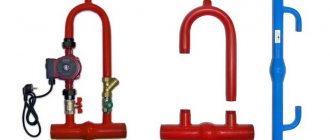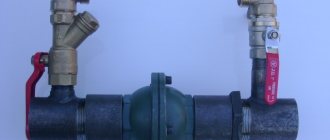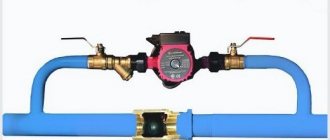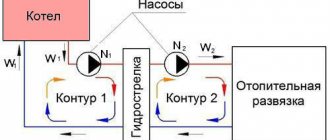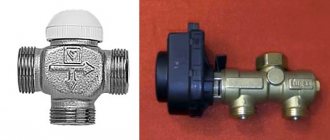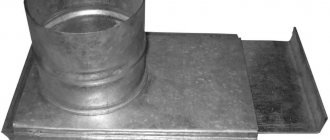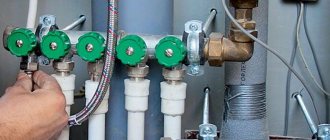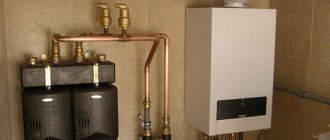The bypass (jumper on the radiator) is a pipe that connects the inlet and outlet pipes of the radiator. Next, let's look at why a heating bypass is needed.
As a rule, multi-apartment buildings use a single-pipe heating system. Typically, hot water goes up the riser and then down, passing through the heating radiators. That is, first the coolant enters the radiators of the upper floors, and then to the lower floors. There are houses where the coolant moves in the opposite direction (from bottom to top) - but the essence of the system does not change. The main feature of a single-pipe system is that the battery in your apartment is directly connected to the battery in the apartment below and above. The question arises: what will happen if someone turns off the radiator - all the neighbors on the riser will be left without heat? This will happen if a bypass (jumper) is not installed on the heating battery. If there is a bypass, the coolant will flow further along it, bypassing the blocked battery.
In what cases is a jumper not needed?
If there is no tap on the battery that can be used to turn it off, then a bypass on the heating radiator is not needed. After all, there is still no way to shut off the battery without disconnecting the riser.
In cottages and some new buildings there is a two-pipe heating system. In this case, each radiator is independently connected to two pipes - supply and return. A jumper is not used in this scheme, since the batteries do not depend on each other. The temperature in two-pipe systems is usually automatically controlled.
Rules for installing a bypass in a heating system
It is advisable for specialists to install the bypass on the heating battery. They will install all equipment according to established rules and standards, perform pressure testing of the system, and check for defects. But if a situation arises when you need to install the jumper yourself, use a number of rules that will help you do this.
- The determining role when installing the jumper is played by the correctness of the calculations made. The bypass diameter should be one size smaller than the pipe diameter. You can take a ready-made jumper, or make it yourself.
- If you have not installed such elements before, it is better to take a ready-made jumper. This will reduce the likelihood of errors to a minimum.
- The bypass cannot be placed directly on the riser. It should be moved closer to the radiator. However, you cannot install it end-to-end, as this can lead to improper operation of the heating system and overheating of the return current. As a result, the effect of installing a jumper becomes minimal.
- After installing the bypass, it is necessary to carry out a pressure test with a pressure 1.5 times higher than the calculated one and check the system for leaks.
Is it possible to put a tap on a bypass?
Some residents of apartment buildings place a faucet on the jumper, wanting to increase the ability to regulate temperature. However, in the case of an apartment building, this is a serious violation. The valve can interfere with the flow of liquid and disrupt its proper circulation throughout the riser.
Even with a valve, the battery will not heat up any more. And instead of improving the microclimate in the apartment, you can turn off the bypass tap and forget about it. As a result, you will have to deal with neighbors from frozen apartments.
Let's figure out whether it is possible to install a tap on the bypass when piping a heating radiator in apartment buildings.
- How does a radiator with bypass work?
Let's take a quick look at how a radiator with a bypass works. Some call it the third piece.
As a rule, valves are installed at the inlet in front of the radiator.
Coolant supply can occur both from below and from above. Let's consider the option when the coolant is supplied from above, reaches the radiator with a bypass and is divided into two flows.
One part of the coolant enters the radiator and causes it to heat up, while the other part passes by the radiator through the bypass and moves further along the riser. Using a valve installed at the inlet in front of the radiator, we can control the flow of coolant and thereby increase or decrease the power of the radiator.
A shut-off valve is installed on the return line.
During the heating season, it is usually completely open. The most interesting thing is that more coolant passes through the bypass than enters the radiator, and this is considered normal with good circulation and normal coolant temperature.
Unfortunately, not everyone has everything set up perfectly. For some, the coolant arrives through the riser already half-cooled, for others the circulation is poor, so many installers or apartment owners themselves decide to install the tap on the bypass.
Some install it just in case, and some know for sure that they will close this tap. By closing the bypass valve, we force all the coolant entering through the riser to pass through the radiator.
Thus, we seem to be trying to squeeze out as much heat as possible from the coolant that passes through our radiator. But before it enters the radiator, the coolant passes through the valve.
The valve design is designed to ensure coolant flow to only one radiator. If we look into a pipe, for example, 3/4 inch, through which coolant flows into the radiator, and compare it with the valve, then with the naked eye we will see that there is a very strong narrowing on the valve.
If we look at the valve in section, we will clearly see what small hole the coolant needs to pass through to get into the radiator.
Now imagine a multi-story building. By closing the bypass valve, you force all the coolant to flow through the valve, which can only provide coolant flow to one radiator.
Yes, in this case, your radiator, of course, will heat a little better, but keep in mind that in this case you disrupt the circulation of the entire riser from the first to the last floor. All your neighbors' radiators will heat up worse.
Of course, there will be complaints, and sooner or later, when they come to you with an inspection, they will force you to redo everything at their own expense. At the same time, you may still be made guilty of all the troubles and shortcomings of your home’s heating system. By the way, some neighbors whose radiator began to heat worse will also decide to install a tap on the bypass.
Thus, through collective efforts you will finally finish off a system that is not working very well anyway. At the same time, the radiators will heat up even worse, including yours. If you still hope that you will ruin the weather only for your neighbors, then you are mistaken. In some houses, the heating system is designed in such a way that the coolant rises up one riser and goes down through the other riser.
Radiators are also installed on the riser where the coolant rises. Thus, you disrupt the circulation not only on your riser, but also on another, and the radiator, which began to heat worse on the second riser, may end up installed in your bedroom.
From this we conclude that it is better not to install the tap on the bypass.
- Tips to help when replacing radiators
What to do if you decide to change the radiators in your apartment and you suspect that the heating system in your house is not working perfectly? Firstly, install radiators with a good power reserve, and secondly, when piping a radiator, it is better to install ordinary ball valves instead of valves. If we look at the faucet closely, we will see that when the faucet is open, we have practically no narrowing.
The only drawback is that we will no longer be able, as with a valve, to regulate the flow of coolant and the power of the radiator. When installing ball valves on a radiator, we ensure good flow and circulation of coolant through our radiator.
Additionally, you can play it safe and make the bypass one diameter smaller than the main pipe.
After this, the radiator will most likely heat well enough, and there will no longer be a need to install a tap on the bypass. But if you still decide to install it, you can only do this if you connect the radiator using full-bore normal ball valves.
In this case, when closing the tap on the bypass, you will ensure the normal flow of coolant through the radiator without any narrowing, and the circulation in the riser will also be normal.
Advise your neighbors to do the same - and there will be enough heat for everyone, everyone will be happy!
We hope you found these tips useful and that you found a lot of valuable information in them.
All rights to the video belong to: Marat Ishmuratov
Bypass is a side pipe or bypass that serves for the normal operation of the coolant, bypassing heating devices installed in an isolated apartment. One end is connected to the hot water outlet, the other to the coolant input. The bypass allows you to replace radiators in rooms during the heating season, carry out maintenance of heating devices and more. Very often the bypass tap is sacred, which causes controversial debates. Whether this can be done or not, we’ll figure it out in the article.
Why do you need a jumper on radiators?
A jumper on a radiator, or bypass, is a special pipe that allows you to isolate the battery from the heating riser. In a single-pipe system, water moves through the riser from top to bottom or vice versa, heating apartment after apartment on each floor. From the pipe, hot water enters the battery and, after passing through it, returns to the common pipe.
A single-pipe heating system is a multi-level structure of dependent flow radiators subordinate to one heater
The bypass connects the common riser pipes to each other, which makes it possible to adjust the radiators in the apartment without shutting off the heating throughout the house.
The bypass allows you to route the heater through the riser, bypassing the radiator, which makes it possible to control the temperature of each battery using a regulator
By and large, the jumper allows you to:
- turn off the heating in a specific radiator, remove or replace the battery, which may be necessary in the event of a leak or repair of the apartment;
- install heating regulators on each individual radiator, which makes it possible to independently set the microclimate in the rooms of the apartment.
Bypass is legally permitted and can be implemented in the heating system in any apartment without exception. According to the standards, the jumper must have a smaller diameter than the main heating pipe of the riser; water shut-off valves or regulators cannot be installed on it. Fittings, meters and filters can be legally installed only if they are located after the bypass and do not interfere with the heating of the entire riser.
If there is a bypass, heating regulators, as well as flow and shutter valves, are installed after the riser jumper
Three types of bypasses
There are three types of bypasses:
- Unregulated - simple pipe;
- With manual control – valve with divisions;
- Automatic – with sensors;
The latter option is installed in a harness with a pump. Typically, automation is used when circulating a coolant along a circuit. An electrically powered pump allows you to increase the flow rate, which helps reduce heat loss. Most often, such a system is used in private homes or when connecting heated floors to the heating system in apartment buildings. In the event of a power outage, the coolant flow passes through the bypass. The impeller restricts the flow of water. It is supplied to the market in two variations: injection and valve. The biggest disadvantage of an automatic bypass: if the water contains scale, scale, rust and other contaminants, it quickly fails. The bypass must be installed in a single-pipe system; if it is necessary to make a collector wiring, the jumper allows you to divide the flows into two parts, providing both radiators with coolant in equal proportions. With horizontal wiring, the bypass is installed parallel to the main line below the normal wiring. When installing standard three-quarter inch pipes, it is recommended to install a bypass at one-half inch. In this case, the pipes of the incoming and outgoing coolant flow should have a diameter of 1 inch.
Installation
Before installation, the coolant should be completely drained from the system. A circulation pump with a bypass is mounted on the cold return pipe directly next to the heating boiler. This reduces the impact of high temperatures on equipment.
It is necessary to initially determine the optimal inclusion option:
- For a plastic pipe, it is better to use American-style dismountable connections and connect a pre-assembled pump unit with a bypass. Connect the branch with the pump using tees soldered into the main pipe.
- For steel pipes, first the branch pipes for the branch with the pump are welded, and then the valve on the bypass.
When working with welding, it should be taken into account that the valves do not tolerate overheating. Especially ball ones, where the Teflon insert can become deformed. The connection point of the main pipe should be distanced from the valve using extended pipes or fittings by at least 20 cm on both sides. In this case, the shut-off valves are combined with fittings using threaded connections.
The entire structure must be oriented in such a way that the pump outlets are positioned strictly vertically or horizontally, and the working shaft is strictly horizontal. This will increase the survivability of equipment and reduce the production of parts. All valves must be freely accessible and nothing should prevent them from being closed. Allow sufficient space to allow easy removal of the pump and other components.
Source
Connection diagram
The standard bypass connection diagram in an apartment is as follows:
- Pipe with incoming coolant flow;
- Bypass;
- Pipe with outgoing coolant flow;
- Shut-off valves for inlet and outlet.
In this brief description we will look at the operation of a radiator with a bypass. Two valves are mounted at the inlet and outlet of the radiator. The coolant is supplied from below or from above. For most heating systems, the second option is correct. When hot water is supplied from above, the liquid reaches the bypass and is divided into two streams. The coolant is directed to sections of the heating device, heating it. The other flow through the outlet pipe - the bypass, bypassing the radiator, goes down, and then continues its movement along the riser. A valve installed at the radiator inlet allows you to control the flow, increasing or decreasing the coolant supply. A shut-off valve is installed on the bottom of the radiator to allow heat to be removed. During the heating season, the drain valve is opened all the way.
Bypass and circulation pump
Autonomous heating is the optimal solution for a country house. The system is often equipped with a pump that provides forced supply of coolant, which improves its operating efficiency. The pump consumes electricity, but the installation is economically justified by increased heat transfer.
The disadvantage of the pump is its dependence on the power source. In the absence of electricity, the unit stops working, and communication efficiency decreases. To prevent problems from occurring, experts recommend using bypasses for the circulation pump.
In this case, the pump is connected to the system via a bypass. In other words, it is installed on the jumper itself. Valves are installed on both sides. At the same time, a tap is installed on the main line between the inlet and outlet of the jumper. In normal mode, water flows through the bypass. If there is a loss of electricity, then the taps on it are closed, and on the main line they are opened. The coolant is redirected directly bypassing the bypass.
Taps are installed on the jumper with the pump
Why install a bypass
More hot water passes through an additional tube connecting the incoming and outgoing flows, and correspondingly less of it enters the radiator. This is normal and fully complies with housing and operational standards, if good circulation of hot water is ensured and the standards for heating the room are observed. In practice, in apartment buildings on the upper and lower floors (depending on the type of coolant supply), there is a significant decrease in temperature in the radiators due to the natural cooling of the coolant. In this case, additional losses through the bypass affect the rate of heating of the room. The hot water supplied to the apartment from the common system, as a rule, circulates poorly due to accumulated rust and scale. In some cases, pipes are installed incorrectly, with a narrowed inlet flow diameter.
Principle of operation
The coolant, water, and gaseous medium, moving through the pipeline, exert pressure on the valve, which is held in place by a spring. As soon as the pressure force reaches a predetermined level, the valve opens and the excess volume of the working medium is discharged through a special branch into another circuit of the system.
After the level drops to normal, the spiral returns the valve to its original position and the contents of the pipeline continue to circulate.
In a car, the turbine bypass assembly has a damper, the full opening or closing of which depends on the activator lever. The length of its pull can change over time under the influence of various factors. Therefore, this is monitored and the traction is adjusted.
Valve design
A standard three-quarter-inch valve is designed to provide acceptable pressure and coolant flow rate for one radiator. If you take a standard size pipe and compare it with the diameter of the valve, you can see a significant narrowing in the diameter of the latter. A valve with a smaller diameter is installed to increase pressure. The narrowed hole interferes with the normal circulation of the coolant, thereby disrupting the heat supply to one or more risers. A slight narrowing of the diameter will cause the room temperature of all neighbors to drop. In addition, in the neighboring rooms of the apartment, the batteries will begin to cool faster.
About responsibility for installing a bypass valve
Having received a dozen complaints, representatives of the housing maintenance service will come with an inspection and quickly discover the problem. The apartment owner will be required to correct problems in the system at his own expense. It is quite possible that the fault for the low temperature in the batteries lies with the housing office itself or the company providing technical repairs. But all accusations will be directed towards the person who installed the tap on the bypass, disturbing the thermal balance. If several people install such taps, this will lead to a heating collapse. The whole house can be damaged. The design of some multi-storey buildings assumes the following: the coolant can rise in one riser, pass along the technical floor, and fall in another, thus continuously circulating. By placing a barrier at one point in the system, the tenant disrupts the thermal balance in two risers at once. Another riser may well be located in the same apartment. The result will be the following situation: one battery, located in the living room, heats better, the other, located in the next room or kitchen, heats worse.
Alternative ways to raise your temperature
The surest solution is to increase the number of radiator sections. The longer the heating device, the more heat it can release into the room. Second method: replace the fans installed at the inlet of the heat flow battery with standard ball valves. Ball valves allow water to pass through the entire ceiling without restriction. Unfortunately, using such a faucet you cannot adjust the coolant flow. A plus is good water circulation in all directions. Another disadvantage of ball valves is the effect of sticking of internal parts. After a long period of inactivity, the faucet stops turning off the flow of water. Ball valves require periodic maintenance. They must be opened and closed periodically.
Tips and tricks
Before proceeding with the installation of a bypass in the heating system of an apartment building, first of all, you should notify representatives of the local housing and communal services in writing about your decision in order to agree on the issue of temporarily shutting off the coolant supply from the boiler room. After that, follow these recommendations:
In order for water to flow normally into the heating device, it is necessary that the diameter of the pipe in the bypass section be one size smaller than in the general circuit. When purchasing a ready-made bypass unit, it is necessary to require a quality certificate, which will serve as a guarantee of durable and normal operation of the device. When purchasing elements of the bypass section, you should check the threaded connections - they should be easy to unscrew and not twist when tightened. When deciding to install a bypass, use only ball valves, since they not only have low hydraulic resistance, but are also easy to open and close. It doesn’t matter whether the bypass is working or not, it is necessary to open and close all the valves from time to time to avoid sticking of the ball and will significantly increase the service life of all elements of the assembly. Before putting the heating into operation after a long period of inactivity, it is imperative to ventilate the area with the circulation pump. Throughout the heating season, preventive cleaning of filters installed in the bypass system should be carried out. To avoid mistakes and to ensure that the heating works efficiently, it is advisable to entrust all work to an experienced specialist.
Bypass installation examples
How to solve the problem without a bypass valve
To prevent the bypass from taking away precious heat, you need to install an adapter pipe with a diameter smaller than the inlet and outlet pipes. Liquid always follows the path of least resistance; the lower the pipe diameter, the greater the pressure and vice versa. The water entering the apartment is immediately divided into two streams, the first goes down, the second passes through the battery. Therefore, the rules for using heating appliances recommend setting the diameter of the jumper one unit less than that of the direct-flow pipe. For example, if the pipe diameter is 1 inch, a three-quarter jumper must be installed. This will get rid of the effect of the first sections of the radiator being too hot and the last sections being quite cold. Since the liquid moves into the drainage system with some resistance, the pressure at the entrance to the batteries increases, and all sections receive an equal amount of heat. Narrowed bypasses are provided for by the standards; the local HOA or housing cooperative will have no complaints.
Bypasses with manual adjustment
Bypasses that are adjusted manually (manual bypasses) are equipped with ball valves. The use of ball valves is determined by the fact that they do not change the pipeline capacity at all when switching, since the hydraulic resistance in the system does not change. This quality makes the ball valve an optimal option for bypass.
Shut-off valves of this type allow you to regulate the volume of liquid that passes through the bypass section. When the tap is closed, the coolant moves in full along the main line. The operation of ball valves has one important nuance - they need to be turned regularly, even if there is no need to adjust the system. This is due to the fact that if left stagnant for a long time, the taps may become tightly stuck and will have to be replaced. Sometimes a heating system feed valve is also installed, which plays a significant role.
Is it possible to dismantle the bypass?
It is not recommended to remove the jumper between the two pipes. In the standards for the construction of residential premises, back in the seventies, it was decided to install such jumpers for central heating radiators. The bypass helps ensure the smooth flow of coolant through your apartment, regardless of whether heat enters the radiator or not. Why this is necessary: Without sealing the battery, there is no way to prevent leakage. If the heating device becomes clogged, you will have to turn off the system and leave an entire riser or two without coolant.
Heating scheme. What is the dispute about, exactly?
The heating circuit assumes both the presence of a tap on the bypass and its absence. Let's look at these 2 options:
with bypass valve:
without bypass tap:
If you surf the Internet, you can come across completely opposite points of view from both individuals and companies involved in the installation of central heating batteries.
If you look at the root, the problem is much deeper than it might seem at first glance. And it lies in the plane of affecting the interests of individuals and entire organizations.
Let's remember once again why a bypass is needed in principle. A bypass (aka jumper) is installed in front of the battery, providing an independent flow of hot water through your apartment. In a word, whether you have a battery or not, whether it is in good condition or bad, water must flow through your apartment, regardless of these factors, through the jumper.
Therefore, the fact that a jumper is needed is an indisputable argument. If, for example, you do not have a bypass at all, and only a battery is connected to the pipe, then this can lead to very unpleasant consequences:
- If the battery suddenly leaks, there is no way to stop the leak—the neighbors below are guaranteed to flood.
- If the battery suddenly gets clogged, then you block the entire riser, and your neighbors are left without water.
You can't argue against these arguments.
And then, regarding the bypass tap, whether it is needed, there is constant debate.
By the way, I will say that both options for installing heating radiators, which you saw above in the pictures, were made by 2 different licensed companies. Each has its own truth!
